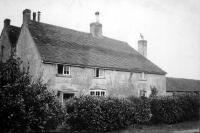|

|
Walnut Tree Cottage, Goring Street, Goring by Sea
Walnut Tree Cottage stood adjacent to Goring railway station, separated by a small field. The house stood at right-angles to the road. On its east side was an embankment built in preparation for a bridge over the railway, with work suspended during the war. The embankment now carries the A259, but back then the only thing there was a Bofors anti-aircraft gun: this 10-year old was told by the soldiers to keep well away.
The signal box by the crossing has now gone, as have the cottages on the west side of the road. Now the whole country character of that part of Goring has completely gone. One thing remains, which is the lower part of Walnut Tree Cottage's flint garden walls which still now front Campbell Court. They were originally some 12 feet high. We had many chickens which roamed the garden, and a good potato crop.
The cottage was adjacent to a small dairy farm (to the right of the picture) which had a field for the cows alongside Goring Street, reaching south to the main road. Often for breakfast I enjoyed milk directly from the dairy.
Walnut Tree cottage was quite large (staircases back and front), and had fine flagstone floors. We had no heating beyond a small stove, and no electricity. An Aladdin paraffin heater provided heat, and light came from paraffin lamps and candles. A chemical lavatory in a small wooden hut stood in the garden near the cottage.
On the other side of the road was a thatched cottage in which a Mr & Mrs Norris lived. Mrs Norris possibly prevented the house from destruction for, when lighting the primus in the kitchen I had spilled methylated spirit on to the supporting tray. A mass of blue flames appeared surrounding the stove’s paraffin tank. My mother being out, I ran across to get Mrs Norris. She used a large damp cloth to extinguish the flames. Very near to disaster.
Returning once from school in Worthing our train was bombed and machine-gunned near Durrington Station. The nearby gas-holder went up in flames and a young girl on the train was killed. I walked home along the railway track. Another wartime memory is the sight of German prisoners of war being marched down Goring Street.
I was most upset (and I still am!) to learn the cottage had been destroyed. I seem to remember that, at the time, I was told the cottage was 100 years old, so let us say it was built around 1840 (experts might disagree and I have now learned that the house might well have had medieval origins.)
We later (1946-47) moved to 215 Goring Way.
Michael Harrison
November 2010
|
|
 | | Walnut Tree Cottage, Goring Street | |
To add a comment you must first login or join for free, up in the top left corner.
|
|


